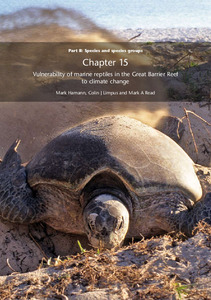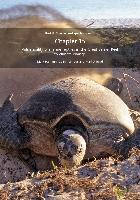Please use this identifier to cite or link to this item:
https://hdl.handle.net/11017/547

Full metadata record
| DC Field | Value | Language |
|---|---|---|
| dc.contributor.author | Hamann, M. | * |
| dc.contributor.author | Limpus, C.J. | * |
| dc.contributor.author | Read, M.A. | * |
| dc.date.accessioned | 2012-08-08T06:32:49Z | null |
| dc.date.available | 2012-08-08T06:32:49Z | null |
| dc.date.copyright | 2007 | en |
| dc.date.issued | 2007 | en-US |
| dc.identifier.isbn | 9781876945619 | en |
| dc.identifier.uri | https://hdl.handle.net/11017/547 | null |
| dc.description.abstract | Marine reptiles are an important and well-documented component of the Great Barrier Reef (GBR), comprising a single species of crocodile (Crocodylidae), six species of marine turtles (five Chelonidae and one Dermochelyidae), at least 16 species of sea snakes (Hydrophiidae), one species of file snake (Acrochordidae) and one species of mangrove snake (Colubridae). Together these marine reptile species inhabit or traverse through each of the 70 bioregions identified by the Great Barrier Reef Marine Park Authority Representative Areas Program . These marine reptile species, with the exception of some of the snakes, have distributions that span large areas of the GBR. Crocodiles, marine turtles, file snakes, mangrove snakes and sea snakes all have life history traits, behaviour and physiology that are strongly influenced by temperature. All are ectothermic except for the leatherback turtle and thus their body temperatures fluctuate with environmental temperature. For egg laying species (crocodiles and turtles), the temperature of the nest determines incubation period, hatching success and hatching sex ratio. Thus as a group they are potentially vulnerable to climate change. | en |
| dc.publisher | The Great Barrier Reef Marine Park Authority | en |
| dc.relation.ispartofseries | Book: Climate change and the Great Barrier Reef: a vulnerability assessment | en |
| dc.relation.uri | https://hdl.handle.net/11017/137 | en |
| dc.title | Chapter 15: Vulnerability of marine reptiles in the Great Barrier Reef to climate change | en |
| dc.type | Book section or chapter | * |
| dc.subject.asfa | Climatic changes | en |
| dc.subject.asfa | Reptiles (aquatic) | en |
| dc.subject.asfa | Coral reefs | en |
| dc.subject.asfa | Ecosystem resilience | en |
| dc.description.notes | This is Chapter 15 of Climate change and the Great Barrier Reef: a vulnerability assessment. The entire book can be found at http://hdl.handle.net/11017/137 | en |
| dc.contributor.corpauthor | Great Barrier Reef Marine Park Authority | en |
| dc.bibliographicCitation.title | Climate change and the Great Barrier Reef: a vulnerability assessment | en |
| dc.bibliographicCitation.stpage | 465 | en |
| dc.bibliographicCitation.endpage | 496 | en |
| dc.bibliographicCitation.authors | Johnson, J.E. | * |
| dc.bibliographicCitation.authors | Marshall, P.A. | * |
| dc.subject.apais | Reptiles | en |
| dc.subject.apais | Environmental impact | en |
| dc.subject.apais | Environmental management | en |
| dc.publisher.place | Townsville | en |
| dc.relation.connectiontogbrmpa | GBRMPA published this item | en |
| dc.subject.category | Animals | en |
| dc.subject.category | Plants | en |
| dc.subject.category | Ecosystems | en |
| dc.subject.category | Processes | en |
| dc.subject.category | Economic values | en |
| dc.subject.category | Social values | en |
| dc.subject.category | Climate change | en |
| dc.subject.category | Coastal communities | en |
| dc.subject.location | Reef-wide | en |
| dc.keywords | Vulnerability assessment | en |
| dc.keywords | CCAP 07/08 | en |
| dc.keywords | CCAP output | en |
| dc.keywords | resilient GBR ecosystem | en |
| dc.keywords | targeted science | en |
| dc.keywords | Marine reptiles | en |
| dc.keywords | turtles | en |
| dc.keywords | A1 | en |
| dc.keywords | B1 | en |
| dc.keywords | A1.2 | en |
| dc.keywords | A1.3 | en |
| dc.keywords | A1.4 | en |
| dc.keywords | B1.3 | en |
| dc.keywords | B1.4 | en |
| dc.keywords | climate change action plan 1 | en |
| dc.keywords | snakes | en |
| dc.keywords | crocodile | en |
| Appears in Collections: | Effects | |
Files in This Item:
| File | Description | Size | Format | |
|---|---|---|---|---|
| Chapter-15-Vulnerability-of-marine-reptiles-in-the-Great-Barrier-Reef-to-climate-change.pdf | 709.27 kB | Adobe PDF |  View/Open |
Items in ELibrary are protected by copyright, with all rights reserved, unless otherwise indicated.
